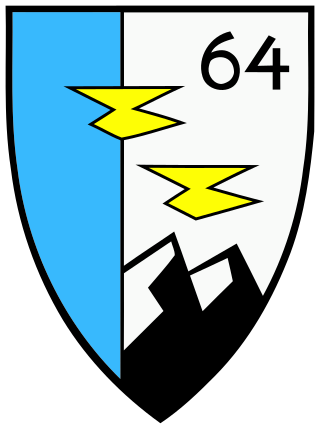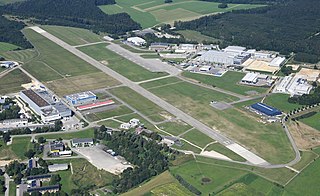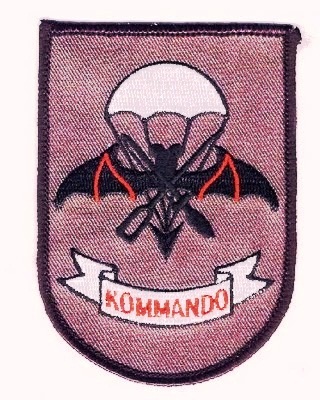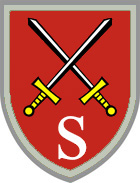
The Bundeswehr is the armed forces of the Federal Republic of Germany. The Bundeswehr is divided into a military part and a civil part, the military part consisting of the German Army, the German Navy, the German Air Force, the Joint Support Service, the Joint Medical Service, and the Cyber and Information Domain Service.

The German Army is the land component of the armed forces of Germany. The present-day German Army was founded in 1955 as part of the newly formed West German Bundeswehr together with the Marine and the Luftwaffe. As of January 2022, the German Army had a strength of 62,766 soldiers.

Laupheim Air Base is a German Air Force base located close to the city of Laupheim, Baden-Württemberg, Germany. It is home to Helicopter Wing 64 which has 48 of its 60 helicopters stationed at the airbase together with 1,200 personnel.

The history of the German Army Aviation Corps goes back to the time when the German Wehrmacht first began to develop helicopters.
Airmobile Operations Division was a division of the German Army. The division was founded on 1 July 2002 and reported for duty 8 October 2002. Airmobile Operations Division consisted of approximately 14,500 soldiers, 350 of which were stationed at divisionary headquarters in Veitshöchheim, Germany.

Jäger Regiment 1 was an air assault infantry regiment of the German Army. While it comes from the old German tradition of Jäger, it was a relatively recently formed air assault formation, established in 2006. The regiment was part of Airmobile Operations Division, and became subordinate to 21st Armoured Brigade on 19 December 2012. Soldiers of this unit were deployed to the combat zone by helicopters which are supposed to provide fire support as well. Until creation of the Jäger Regiment 1, the Bundeswehr had no air assault capability. The regiment was disbanded and partly replaced by a new battalion in 2015.

Celle Air Base German: Heeresflugplatz Celle is a military airbase of the German Army. The airfield is situated southwest of the city of Celle, Lower Saxony, Germany. It was opened in 1934 and has been in military use ever since. Today the aerodrome is used by a helicopter training school, a helicopter liaison and reconnaissance squadron and a helicopter maintenance unit utilising the type Bölkow Bo-105.
The German School of Army Aviation (Heeresfliegerwaffenschule) based at Bückeburg, is one of the schools of the German Army and is responsible for the training and development of the German Army Aviation Corps' personnel and equipment. Furthermore, the basic training of helicopter pilots of the other components of the German Armed Forces also takes place at the School of Army Aviation.

Bückeburg Air Base is a German Army base located northeast of the city of Bückeburg, Lower Saxony, Germany.

Rheine-Bentlage Air Base was an air base of the German Armed Forces and located near the village of Bentlage, 2 km northwest of the city of Rheine, North Rhine-Westphalia, Germany.

Roth Air Base is located 4 kilometres (2.5 mi) south of the city of Roth in Bavaria, Germany.
The Rapid Forces Division, formerly Special Operations Division, is an airborne division of the German Army that was activated in 2001 and received its current designation in 2014.

Faßberg Air Base is a Bundeswehr base located 2 kilometres (1.2 mi) northeast of the municipality of Faßberg, Lower Saxony, Germany. The air base is jointly used by the German Army (Heer) and the German Air Force (Luftwaffe). Its main user is the German Army Aviation Corps.

Altenstadt Air Base is an air base approximately 1.3 kilometres (0.81 mi) northeast of the Upper Bavarian municipality of Altenstadt, Bavaria, Germany. It is operated by the German Army Aviation Corps.

The 21st Panzer Brigade "Lipperland" is a brigade in the German Army and part of the Bundeswehr. The brigade staff and most of its units are based at the Field Marshal Rommel Barracks in Augustdorf, North Rhine-Westphalia. Several companies are based in Glückauf Barracks in Unna-Königsborn.

Helicopter Wing 64 is a wing of the German Air Force (Luftwaffe). It was subordinate to Air Force Forces Command until that was disbanded in 2013. In 2015 Helicopter Wing 64 was integrated into Air Force Troops Command which is subordinate to Air Force Command.

Medium Transport Helicopter Regiment 25 was a regiment in the German Army, part of the German Army Aviation Corps. It was based at Kurt Georg Kiesinger Barracks on Laupheim Air Base in the German state of Baden Württemberg, Southern Germany. The regiment was founded in 1971 and disbanded on 31 December 2012. Its sister regiment was Medium Transport Helicopter Regiment 15 based at Rheine Air Base.

Neuhausen ob Eck Airfield is a special airfield near the town of Neuhausen ob Eck in the district of Tuttlingen in Baden-Württemberg, Southern Germany. Used as a military airbase by the German Army Aviation Corps until 1994, it was rededicated a special airfield, and is since 1997 the site of the business park take-off GewerbePark Betreibergesellschaft mbH. Since 2002, the airfield also hosts the annual Southside Music Festival.
The following lists German active and reserve units within the structure of the German Army. Reserve units do not possess any heavy equipment and their personnel is intended as replacements for losses sustained by regular units.

The Fallschirmjägerkompanien B1 were paratrooper commando specially trained units of the German Bundeswehr and the predecessor of the current German army's special operations unit Kommando Spezialkräfte.







































